Sizes of a baby blanket

As a rule, young parents strive to give their child the best. Preparing for the birth of a baby, they make repairs, carefully choose a stroller, crib, high chair and much more. In a word, they do everything to make the baby comfortable and cozy.
Healthy, full sleep is one of the most important components of a child's regimen in the first years of life. It is necessary for the baby to grow and develop harmoniously, to be active and make new discoveries every day. The quality of a child's sleep is influenced by many factors, from the temperature in the room to the right mattress and bedding.

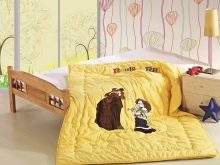

Why is it important to choose the right size?
One of the components that should be given special attention is choosing the right blanket.
It must meet the following requirements:
- high thermal conductivity (quickly warm the child's body, but not overheat it, ensuring proper heat exchange);
- "Breathe", this term refers to the ability of the blanket to pass air;
- release moisture, taking it away from the child's body (hygroscopicity);
- hypoallergenic properties.



It is important that the product is easy to wash without deforming in the process (after all, it is necessary to wash children's clothes especially often), dry quickly and does not require additional care.
It is very important to choose the right size of the blanket for the baby, which will be convenient to use not only for the child, but also for his mother. An unnecessarily large blanket can be heavy on the baby's delicate body, take up a lot of space in the crib, and restrict movement. An option that is too small may also be inconvenient. It will be difficult to completely cover the baby, reliably blocking the access of cold air, In addition, the baby can open up with the slightest movement. Below are the experts' recommendations for choosing a baby blanket.


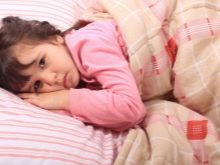
Standard sizes
Bedding manufacturers try to adhere to certain standards when sizing their products. These numerical parameters are optimal, from the point of view of convenience and practicality, during operation. As a rule, the sizes of the blankets correspond to the standards of the produced bedding.
The following is a table of sizes of bedding:
|
Common designation |
Sheet dimensions, cm |
Duvet cover size, cm |
Pillowcase sizes, cm |
|
Euro |
200x240 240x280 |
200x220 225x245 |
50x70, 70x70 |
|
Double |
175x210 240x260 |
180x210 200x220 |
50x70, 60x60, 70x70 |
|
Family |
180x200 260x260 |
150x210 |
50x70, 70x70 |
|
One and a half |
150x200 230x250 |
145x210 160x220 |
50x70, 70x70 |
|
Child |
100x140 120x160 |
100x140 120x150 |
40x60 |
|
For newborns |
110x140 150x120 |
100x135 150x110 |
35x45, 40x60 |

It can be noted that the standard does not imply a wide variety of sizes of children's bedding, however, the choice of options presented on store shelves turns out to be much larger. When choosing bedding, it is very important to pay attention to the fact that the size of the duvet cover matches the size of the duvet as closely as possible. If the duvet cover is too large, the duvet will constantly knock. Moreover, using a blanket that does not match the size of the duvet cover can be life-threatening for the baby.The kid can get tangled in such a duvet cover and get scared or even suffocate.



On the market you can find children's sets that immediately include not only bedding, but also a blanket. The choice of this option is the simplest, since it guarantees full compliance with the dimensions. However, it should be remembered that bedding for a child requires frequent washing, so you still have to pick up an additional set to replace.
A good way out would be to purchase a high-quality comforter of a comfortable size, and sew a set of bed linen to order or on your own. This will avoid problems with finding suitable sizes. And with self-tailoring, you can also get significant savings. Young parents may often have a desire to choose first of all beautiful bedding, and only then choose a blanket suitable for it. However, experts recommend paying more attention to the choice of a comfortable and practical blanket.



Blanket for discharge
Today, manufacturers offer a huge number of options for blankets and envelopes for discharge from a maternity hospital. As a rule, the main aspect when parents choose such an accessory is its design. Usually, however, pretty envelopes are expensive and impractical.

You can replace them with a regular blanket. Nurses in the hospital will certainly help to swaddle the baby beautifully, and in the future you can use this accessory for walking in a stroller. In this case, it is better to purchase a square version with dimensions of 90x90 or 100x100 cm. In addition, such a blanket will later serve as a comfortable warm rug for laying out the baby when he begins to learn to crawl.



When choosing the type and thickness of the product, it is necessary to take into account the season and weather conditions, which are the occasion for the solemn event and the first 3-4 months of the baby's life. Small children grow up quite quickly, so you shouldn't look for an expensive exclusive option, just the right sizes and high-quality filler will be enough.


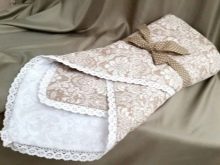
Moreover, the blanket envelope can be sewn by hand. And what could be better than lovingly made little things for your little one? How to do this is detailed in the next video.
How to choose a crib according to the age of the children?
A blanket for a crib should provide the baby with maximum comfort during daytime and nighttime sleep. An inappropriate blanket can be a source of anxiety for the baby. The inner size of a standard bed for a newborn is 120x60 cm, so when choosing a blanket, experts recommend focusing on these characteristics.
If the child often turns over in a dream, then it is better to choose a blanket slightly larger than the width of the bed. Such a reserve allows you to tuck it under the mattress and exclude the possibility that the baby may involuntarily open up in a dream, and the mother will not worry that the child will freeze. For restless children who sleep poorly and often wake up, experts often recommend making a cozy cocoon out of the blanket, tucking it on three sides. This may require larger bedding.

Table of recommended blanket sizes, depending on the age of the child and the bed used.
|
Child's age |
Sleeping area, cm |
Recommended blanket size, cm |
|
|
Newborn crib |
0-3 years |
120x60 |
90x120, 100x118, 100x120,100x135, 100x140, 100x150 110x125, 110x140 110x140 |
|
Baby bed |
3-5 years |
160x70 160x80 160x90 |
160x100 160x120 |
|
Teenage bed |
5 years and older |
200x80 200x90 200x110 |
140x200, 150x200 |
These recommendations are approximate and based on average statistics. The age limits may vary slightly depending on the height and weight of the child. As you can see from the table, the size of the bed for a child over 5 years old is the same as for a regular single bed.Accordingly, starting from about this age, the option of an ordinary one-and-a-half blanket can be considered for a child.



What is the best filler?
Natural fillers
To ensure your baby is as comfortable as possible while sleeping, it is important to choose the right filler for the baby blanket. The type of filler determines the heat-saving properties and affects the price. Traditional natural fillers are breathable, allowing the body to breathe. However, when choosing an option for a child, it should be borne in mind that such a filler is a favorable breeding ground for a tick and can cause allergies.
There are many varieties of natural fillers:
- Downy... In such blankets, natural down (goose, duck, swan) is used as a filler. These products are very warm and light at the same time, which is especially important for babies. Down bedding perfectly tolerates washing and retains its shape;


- Woolen... Natural wool has long been used for the production of blankets. In this case, the product can be either woven from a woolen thread, or quilted, with a wool filler. The latter type is perhaps the warmest and is recommended for use in the cold season. For warmer weather, it is better to choose a semi-woolen blanket (wool with added cotton). Separately, it is worth highlighting blankets with camel wool filling, which has a warming effect. The child's own thermoregulation system is poorly developed and is finally formed by the age of three, so it is important not to overheat the child;
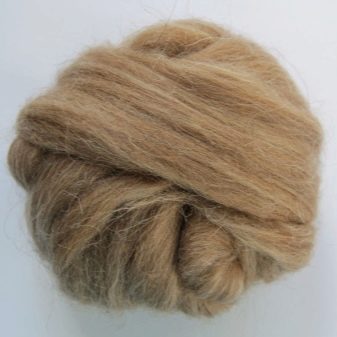

- Baikovoye... Blanket made of natural cotton. Ideal for warm summer weather. Good air permeability, moisture removal. Washes easily and dries quickly;

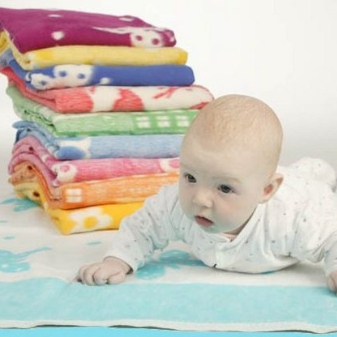
- Fleece. Thin and lightweight fleece blanket is comfortable to use for walking. This material has a sufficiently low hygroscopicity and does not allow air to pass through, therefore it is not recommended to use it for sleeping in a crib. However, such a blanket is indispensable as additional protection from the cold in a stroller, especially in windy or frosty weather. And its low weight and compact size allow you to always carry it in a children's bag in case of a sudden cold snap;

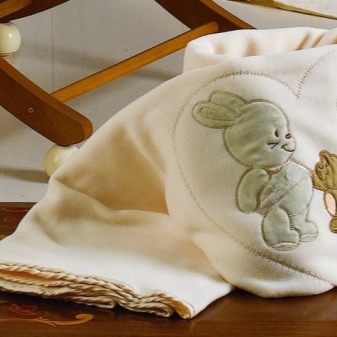
- Bamboo... Bamboo fiber has sufficient strength and resilience characteristics, therefore it is used only in a mixture with artificial fiber. Although according to consumer qualities, products with the addition of bamboo are classified as natural. They have excellent hygroscopic properties and are very comfortable to use. However, it must be remembered that bamboo blankets are not very warm and take this fact into account when choosing such a blanket for a child;


- Silk... Blankets filled with silkworm fibers have very high consumer qualities. Under such a blanket, it is warm in winter and not hot in summer, it allows air to pass through perfectly, does not absorb moisture. Ticks will not start in it. Its only drawback, besides the high price, is that such a blanket cannot be washed. Therefore, given the high cost, silk blankets are quite rare among the range of children's bedding;


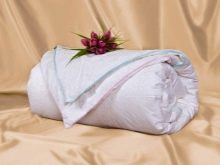
- Wadded... Recently, this type of blanket is practically not used, since it has a number of significant disadvantages. A product filled with cotton wool turns out to be too heavy for a small child. In addition, the cotton filler quickly accumulates moisture and dries slowly, which contributes to the formation of an environment favorable for the growth of mold and mites. Experts strongly advise against using cotton blankets for children.
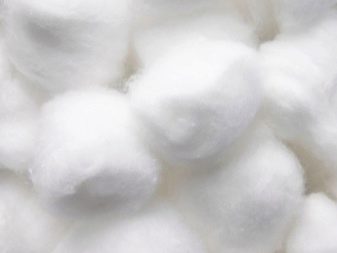

Synthetic fillers
Modern synthetic fillers also have excellent consumer properties.Unlike natural ones, dust mites do not multiply in them, therefore products with such fillers are especially recommended for children prone to allergies, as well as children with bronchial asthma. In addition, bedding with artificial fillers is much cheaper. Considering that children grow up very quickly and the durability of the blanket is not so long, the price plays a significant role in the choice. Let's consider all types in more detail:
- Sintepon... Old generation synthetic filler. Poorly permeates air, not allowing the body to "breathe". Products made of padding polyester quickly lose their shape during operation, especially after washing. The only advantage of this filler is its low cost. If there is an opportunity to refuse such an option, then it is better to opt for more modern fillers.


- Holofiber... New generation filler. Possesses excellent consumer qualities, light and soft, perfectly retains heat. Holofiber products retain their shape well even after numerous washes. Considering the not very high price for holofiber products, such a blanket is one of the most optimal options for children.



- Swansdown. Artificial filler, which imitates natural fluff in its properties, but is devoid of the disadvantages inherent in natural fillers. It is also an excellent choice for use in children's bedrooms.
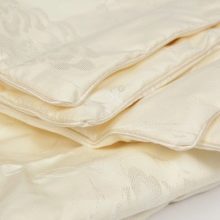


What is the thickness of the blanket to choose?
When choosing the thickness of the filler, it is necessary to take into account not only its heat-saving properties. It is also recommended to pay attention to such characteristics as the ratio of thickness and size.
A small size blanket that is too thick is unlikely to be comfortable to use. In this case, it is better to choose a product with less filler or even a woven version without filler at all. The degree of heat is determined not so much by the thickness of the filler, but by its composition and quality. For example, even a thin camel wool blanket will be much warmer than a thick bamboo blanket.



Summing up, we can conclude that the choice of a baby blanket is an important point that should be given special attention. However, following the recommendations of experts, it is not difficult to choose exactly such bedding that will ensure comfortable sleep and the correct development of the child in one of the most important periods of his life and delight the baby and mother for a long time.














The comment was sent successfully.